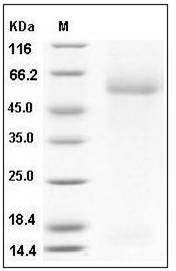-
Product Name
Mouse MARCO (His Tag) recombinant protein
- Documents
-
Description
Macrophage receptor MARCO, also known as Macrophage receptor with collagenous structure and Marco, is a single-pass type IÂ I membrane protein. MARCO is a member of the class A scavenger receptor family and is part of the innate antimicrobial immune system. It is expressed in subpopulations of macrophages in the spleen and the medullary cord of lymph nodes. Although it is expressed on subsets of macrophages, it can be upregulated on other macrophages after bacterial infection. The strategic position of MARCO-expressing cells in lymphoid organs suggests an important role for this bacteria-binding molecule in removal of pathogens. MARCO has a short N-terminal cytoplasmic domain, a transmembrane domain, and a large extracellular part composed of a 75-residue long spacer domain, a 270-residue collagenous domain, and a 99-residue long scavenger receptor cysteine-rich (SRCR) domain. It is possible that cooperation between the SRCR domain and the collagenous domain is needed for high-affinity bacterial binding, or that the SRCR domain has to be in a trimeric form to effectively bind to bacteria
-
Protein name
Macrophage receptor with collagenous structure
-
Protein short names
AI323439; MARCO; SCARA2; LY112
-
Uniprot ID
Q60754
-
Gene Name
Marco; mCG_8472
-
Source/Expression Host
Human Cells
-
Expression Plasmid/cDNA
A DNA sequence encoding the extracellular domain of mouse MARCO (NP_034896.1) (Gln 70-Ser 518) was expressed, fused with a polyhistidine tag at the N-terminus.
-
Protein Species
Mouse
-
Molecular weight
The secreted recombinant mouse MARCO consists of 465 amino acids and has a calculated molecular mass of 47.3 kDa. As a result of glycosylation, the recombinant protein migrates as an approximately 55-60 kDa band in SDS-PAGE under reducing conditions.
-
Purity
> 92 % as determined by SDS-PAGE
-
Validations

Mouse MARCO Protein (His Tag) SDS-PAGE
Related Products / Services
Please note: All products are "FOR RESEARCH USE ONLY AND ARE NOT INTENDED FOR DIAGNOSTIC OR THERAPEUTIC USE"
